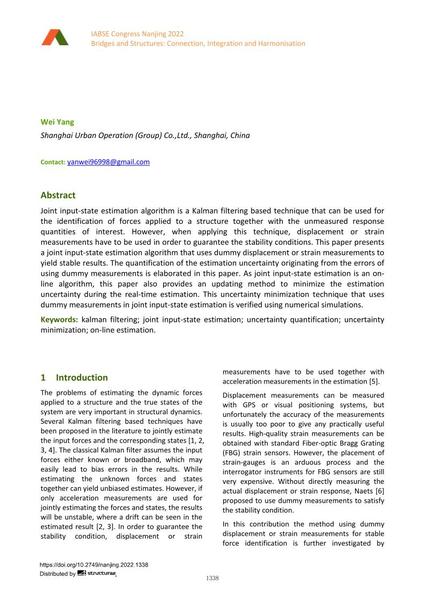Uncertainty Minimization Technique for Joint Input-State Estimation Using Dummy Measurements

|
|
|||||||||||
Bibliographic Details
| Author(s): |
Wei Yang
(Shanghai Urban Operation (Group) Co.,Ltd., Shanghai, China)
|
||||
|---|---|---|---|---|---|
| Medium: | conference paper | ||||
| Language(s): | English | ||||
| Conference: | IABSE Congress: Bridges and Structures: Connection, Integration and Harmonisation, Nanjing, People's Republic of China, 21-23 September 2022 | ||||
| Published in: | IABSE Congress Nanjing 2022 | ||||
|
|||||
| Page(s): | 1338-1345 | ||||
| Total no. of pages: | 8 | ||||
| DOI: | 10.2749/nanjing.2022.1338 | ||||
| Abstract: |
Joint input-state estimation algorithm is a Kalman filtering based technique that can be used for the identification of forces applied to a structure together with the unmeasured response quantities of interest. However, when applying this technique, displacement or strain measurements have to be used in order to guarantee the stability conditions. This paper presents a joint input-state estimation algorithm that uses dummy displacement or strain measurements to yield stable results. The quantification of the estimation uncertainty originating from the errors of using dummy measurements is elaborated in this paper. As joint input-state estimation is an on- line algorithm, this paper also provides an updating method to minimize the estimation uncertainty during the real-time estimation. This uncertainty minimization technique that uses dummy measurements in joint input-state estimation is verified using numerical simulations. |
||||
| Keywords: |
uncertainty quantification kalman filtering joint input-state estimation uncertainty minimization on-line estimation
|
||||
| Copyright: | © 2022 International Association for Bridge and Structural Engineering (IABSE) | ||||
| License: | This creative work is copyrighted material and may not be used without explicit approval by the author and/or copyright owner. |
||||
